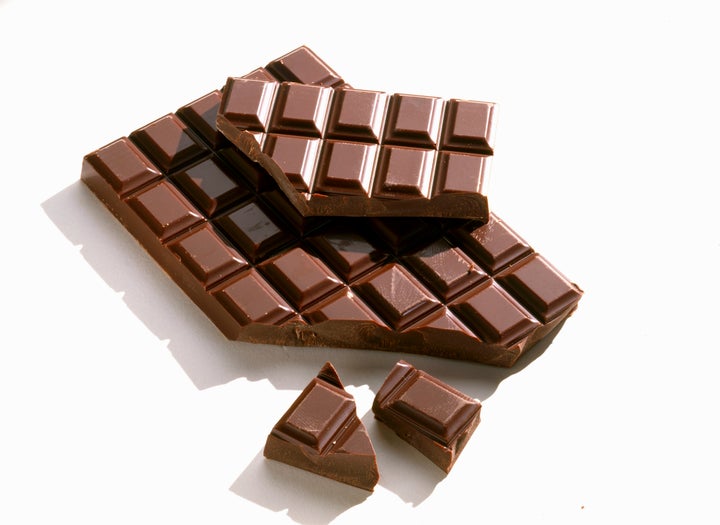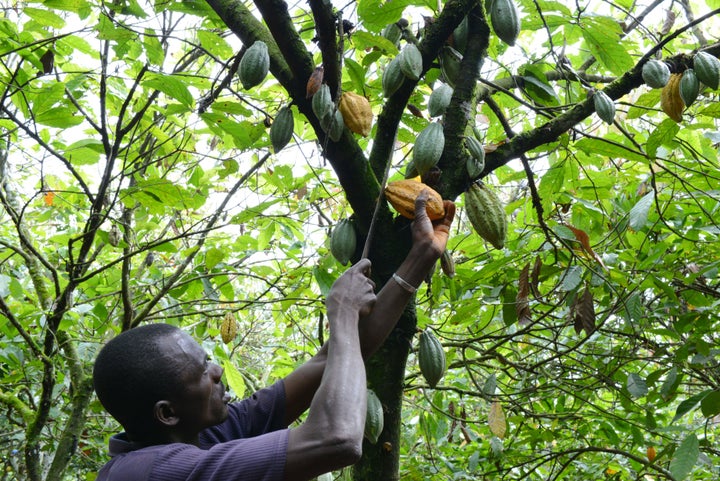
You can walk into any old drugstore and buy a Hershey’s chocolate bar for around a dollar, but a single-origin Madagascar chocolate bar from Salt Lake City-based Solstice Chocolate will cost you $9, and a single-origin Costa Rican chocolate bar from Asheville, North Carolina’s French Broad Chocolates costs even more ($11). What gives?
There are significant differences between mass-produced chocolate bars ― think Hershey’s, Mars, Nestlé and the like ― and their small-batch, bean-to-bar counterparts. But the biggest difference that you, the customer, will notice is probably the price.
Turns out that in many cases, the higher cost is justified. Here’s why.
Premium beans and fair farmer wages come at a premium cost.
When a product like chocolate is sold to the consumer for a dollar, “almost always, someone is paying for it somewhere,” Lawren Askinosie, chief marketing officer of Springfield, Missouri-based Askinosie Chocolate told HuffPost.
In this case, the cost is shouldered by hardworking cocoa farmers, many of whom make less than a dollar a day for growing, harvesting, drying and fermenting the precious beans that are central to the final product. (That included many of Askinosie’s farmer partners before they began working with Askinosie Chocolate, founded by Lawren’s father, Shawn.)
Askinosie Chocolate participates in direct trade and profit-sharing with its cacao producers, meaning the beans are sourced directly from farmers, and a portion of the proceeds of each chocolate bar goes back to them. A transparency report on the brand’s website logs what farmers at each origin are paid for their cacao and how this compensation compares to the farm gate price (market price), the world market price and fair trade price.
“Direct trade is something we’re proud to be recognized for pioneering in the chocolate industry, and for us, it means that we have a direct, meaningful relationship with our farmer partners and throughout the supply chain from top to bottom,” Askinosie said.
Larger chocolate companies, on the other hand, source their cacao through third parties and suppliers. That more complicated infrastructure often means less money for the farmer. While these big producers are making progress in certifying the cocoa they use to make sure farmers receive a fair price and are working under good conditions, it’s not to the same extent as craft chocolate makers.
There are also bean-to-bar makers who don’t source directly from farmers, but who do rely on trusted brokers and companies ― like Uncommon Cacao, which connects small cacao growers to the larger market ― to get their beans.
Organizations like Uncommon Cacao say they aim to “build a more fair and sustainable specialty cacao supply chain.” Uncommon Cacao issues a yearly transparency report that details the realities of growing cacao in each region and supplies information including annual farmer revenue, flavor notes and prices at each point of sale.
The 2017 report reads, “Farmers who produce high-quality beans achieve greater business stability, as growing chocolate makers depend on these beans and farmers for their award-winning chocolate.”
Big chocolate companies are primarily sourcing their beans from West Africa, specifically the Ivory Coast and Ghana, according to Dan Azzara, professor of food and agribusiness at Penn State University. Here, the name of the game is large crop yields and a hardier cacao that is disease- and pest-resistant.

Meanwhile, craft chocolate makers are sourcing top-quality beans from small farms in South America (Ecuador, Venezuela, Bolivia) and elsewhere in Africa (Madagascar, Tanzania), with a focus on flavor. DeAnn Wallin, owner and chocolate maker of Solstice Chocolate, told HuffPost that for the cacao she sources, “The trees are phenomenal and the fermenting brings out the flavors of the cacao,” including fruity and nutty notes.
Price-wise, it comes down to the economy of scale, Azzara told HuffPost. Bean-to-bar chocolate makers pay more to obtain specially grown beans of definitive origin and unique flavor at a fair price that supports the work of cacao farmers.
Bean-to-bar chocolate makers use more expensive ingredients.
Look at an artisanal chocolate bar and you’ll likely find just a few ingredients: cacao beans, cocoa butter and cane sugar. After all, the goal of the chocolate maker is to showcase the hero ingredient: the cacao.
You’d think this would make the cost of the chocolate lower, but it actually has the opposite effect.
“We use as few ingredients as possible because we really believe that it makes for a better-flavored chocolate, and since we’re single-origin, we want to be able to highlight the region and honor the farmers that we feature on our packaging,” Askinosie said.
In case you’re wondering, single origin means the chocolate is made using beans from the same place, whether it’s one particular cacao farm or one particular country.
Chocolate makers sometimes add additional cocoa butter for a smoother texture, which makes the chocolate easier to work with and enhances the mouthfeel of the final product. Cocoa butter is an expensive ingredient, and while purists like Askinosie press their own cocoa butter from the same beans they used to make the chocolate (this technique results in a flavor profile that more strongly represents a particular origin), others opt to use an industrial cocoa butter purchased elsewhere.
Even cheaper than industrial cocoa butter? Lecithin.
Lecithin, an emulsifier, makes for a smoother, more fluid chocolate, which is especially key in industrial chocolate-making because the mixture needs to flow through the factory, according to Azzara, who has past experience in the chocolate industry.
He notes that soy lecithin is usually added in small amounts that don’t affect flavor (about 0.1 percent) to act as a processing aid. Vanilla is another common additive ― and one you’ll see less in dark chocolate artisanal bars because craft chocolate makers are most interested in highlighting the nuanced flavors of the cacao beans they’ve paid a premium price for.
Artisanal chocolate takes more time to make, and time is money.
Taste-wise, there are different expectations for an artisanal bar versus, say, a Nestlé Crunch bar. For the latter, consumers are expecting the same experience every time, whether they’re eating a Crunch bar in a different country or tasting one for the first time in a while. Craft chocolate, on the other hand, can differ from one batch of beans to the next, much like different vintages of wine. The processes for making industrial and craft chocolate reflect these differences.

Mass-produced chocolate has a smoother finish than artisanal chocolate. “You can tell just by eating [craft] chocolate that it’s grittier,” Azzara said. “Large chocolate makers will refine and reduce that particle size ― and particularly European chocolates, Belgian chocolates and chocolates we would think of as high-quality on the mass-produced side are very smooth.”
In bean-to-bar chocolate, makers work in small batches and carry out many of the steps by hand. At Askinosie, there’s a 70-step process from bean to bar, which includes roasting beans on a refurbished coffee roaster from Colombia that’s set to a specific temperature dictated by the origin of the beans, tasting them throughout the process and making any necessary tweaks. Molds are filled by hand with tempered chocolate, and each bar is checked before being hand-wrapped.
Experience working with chocolate from certain origins gives makers a general idea of ideal temperatures and time required for each step of the process, but part of being an artisan is to make adjustments as needed for each new batch of beans to showcase the flavors of the cacao.
Like many great things, making artisanal chocolate takes time. Despite having a lot of machinery, it takes Wallin several days to produce a significant amount of chocolate ― 40 to 50 kilos (88 to 110 pounds) ― but she says the end product is well worth it.
“When it’s made in small batches, the flavors are allowed to meld together and be brought out,” she told HuffPost.
To put production size into perspective, Askinosie approximates that her company processes the same amount of beans in one year as a Mars plant does in one day.
So there you have it: In a mass-produced chocolate bar, you have a cheaper price and a consistent flavor, while an artisanal bar tells the story of the cacao bean, from the farm where it’s grown to the inherent flavors of the cacao.
Though it may be significantly more expensive, at around $10, a bar of craft chocolate is a sweet (and relatively affordable) way to #treatyoself. As Askinosie puts it, “There’s not many instances where you can get the best of something for $10. And right now, in craft chocolate, you can spend $10 and truly get the absolute best of the best chocolate that there is in the world.”